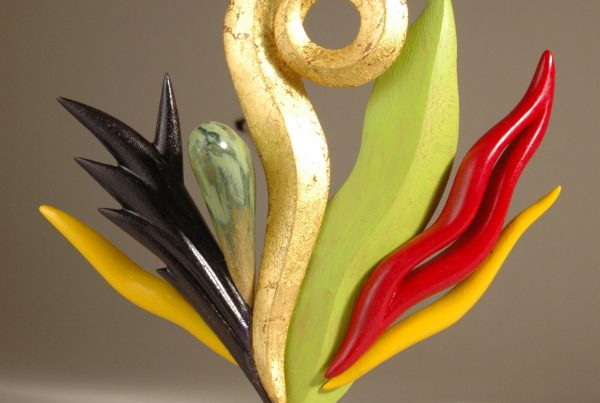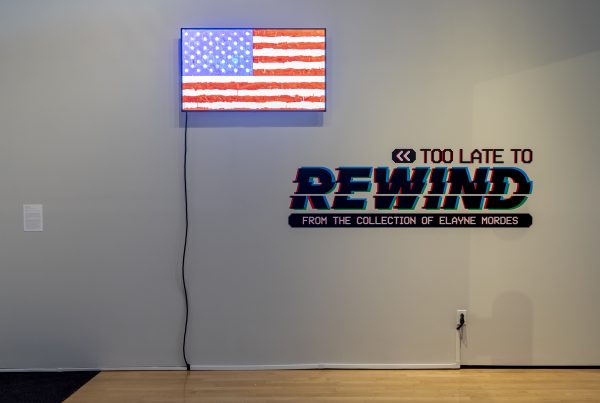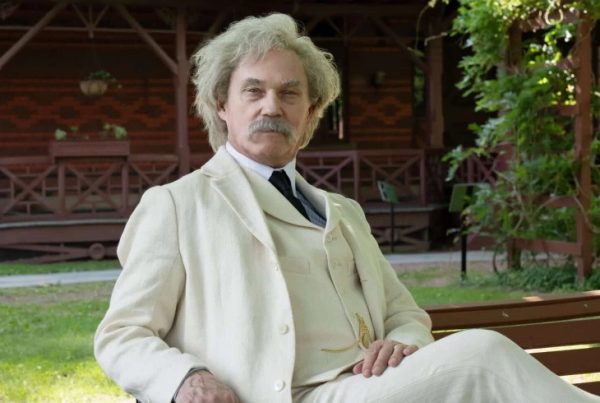
In my favorite sculpture in the Cornell Museum’s recently opened “Wild” exhibition, a giant stuffed bear the color of Sesame Street yellow emerges from an ironically cheerful box. On each of the box’s four sides, a road sign-style image represents a different threat to his habitat: housing, hunting, cars and forest fires. Painted yellow arrows leading from each side suggest that no matter where the bear turns, extermination awaits.
And it’s wearing Mickey Mouse ears, which is no cute filigree: The piece, by artist Diane Arrieta (who creates art under the pseudonym Birds Are Nice), is titled “My Kingdom Ain’t So Magic,” and is a response to news that Disney World’s perpetual expansion comes at the cost of black-bear dwellings.

Arieta’s work represents the essence of “Wild,” another of the museum’s eclectic, winning group shows of paintings, sculptures, installations and mixed-media art gathered around a particular subject: in this case, the natural world. It all started with New Orleans-based artist and activist Alex Beard, the nephew of the pioneering nature photographer Peter Beard and a formidable progenitor of a painting style he calls “abstract naturalism.” His swirling, dripping, mathematically precise art, as well as his preservationist nonprofit the Watering Hole Foundation, inspired Cornell curator Melanie Johanson to organize this exhibition, and he’s the ostensible main draw of the show: His large-scale paintings are the first things you see when you enter either side of the Cornell.
But once she discovered other powerful artists who fit the theme, the exhibit flourished. Like an octopus, its many tentacles encompass numerous mediums, moods and levels of outrage. There is room, under the wide net of “Wild,” for Jonathan Stein’s meticulous, kaleidoscopic “Sunrise/Sunset” photomontages, a departure from the artist’s often-campy aesthetic; Jessica E. Moore’s ghostly charcoal-on-paper drawings; Caitlin McCormack’s animal scenes made from crocheted cotton string; and Chad Steve’s lighthearted ceramic sculptures of animals sitting on unorthodox objects.

Ernesto Kunde’s trippy, excitingly manipulated South Florida mangrove landscapes represent a vanguard in modernist subjectivity, while on the other side of the realism curve, Carin Wagner’s paintings of plant life are breathtakingly photorealistic. She expresses a mastery of light, shadow and form in “When Flowers Turn Their Backs II,” and her “Tree Within a Leaf” looks like the kind of high-definition still that would sell televisions. Somewhere in the middle of this spectrum reside Palm Beach County’s plein air artists, whose sun-dappled take on county landmarks line the walls in the inner galleries, localizing this celebration of the untamed outdoors.

But the most memorable pieces are the ones, like Arieta’s, that most overtly take a stand. The poaching of rabbits, and the capture of other animals for their meat and hides, is central to Elizabeth Jordan’s disturbing sculptures. Using earthen materials like wood, leather, burlap, twine and claystone, Jordan’s “Laws of Magic” is a sculptural triptych of rabbits covered and blinded in wire and mesh, its title perhaps alluding to the exploitation of bunnies in magic shows. Her “Sisters” is more haunting still; a pig and a lamb are tied or chained to slabs of bark, each presumably awaiting its doom.
In his elaborate and deceptive installations, Carlton Scott Sturgill creates “natural” settings from consumerist material. The titular pale-yellow flowers covering the top of a fence in his “Branded Rose Bushwick” are transparently fake, but they go beyond that: They are made from Ralph Lauren shirts, with some of the roses even displaying the brand’s tags—a comment on the loss of plant habitats at the hands of the twin threats of suburbia and capitalism.

Likewise, Karla Walter’s “Adaptation” is a piece you won’t soon forget. It’s a bird’s nest bound up in a tangle of wire coat hangers, the sculpture’s title a sad reminder of the changes thrust upon our mammalian kin by the inevitability of progress. You don’t have to be an animal lover for your heart to weep just a little bit.
“Wild” runs through April 17 at Cornell Museum of Art at Old School Square, 51 N. Swinton Ave., Delray Beach. Admission is a $5 suggested donation. For information, call 561/243-7922 or visit oldschoolsquare.org.







